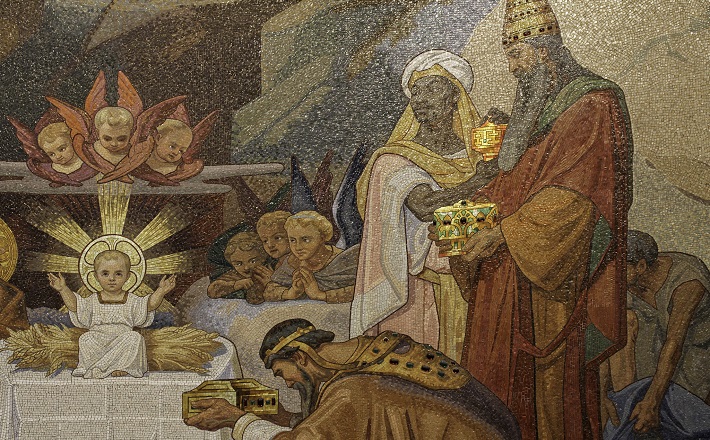Commentary on Isaiah 60:1-6
Isa 60:1-6 is a piece of poetry brimming with energy and hope.
Due to the fact that Hebrew distinguishes between a male and a female second person, we can see that the prophet is addressing a feminine “you.” Thus, scholars identify the poem as belonging to a group of poems within Isa 40-66, which are written to Zion, who is personified as a human female (see also 49:14-26; 51:17-52:12; 54:1-17; 62:1-12). “Arise! Shine!” the prophet calls to her, summoning Zion to bear witness both to the wonder of God’s sudden appearance as well as to her own renewal and restoration.
The original recipients of this prophetic word were Jews living in Judah — now the Persian province of Jehud — in the period following the Babylonian exile. Living in reduced circumstances amidst the rubble of a wealthier time, the people’s historical visions of a glorious Zion might have seemed a distant fantasy. Zion, both the geographical locale as well the idea of a sacred bond between people, place, and God, was in ruins. The Zion poems of Isa 40-66 represent an attempt to rebuild the idea of Zion and to infuse her with a new vigor. This effort is not simply to make people feel better nor to reclaim a theological idea for its own sake. The purpose of the rehabilitation of Zion is to inspire and empower the people to help make this glorious vision a reality. Isa 60:1-6 is, thus, not a simplistic prediction of a new age but contains a call, an imperative, to be a part of the restoration of Zion.
The imperatives are what drive Isa 60:1-6. The reader is propelled through the poetic unit by the two imperative pairs that occur at v. 1 and v. 4: “Arise! Shine!” and “Lift up your eyes and look around!” Following these commands, the prophet describes the scene before Zion using verbs in the prophetic present and so adds persuasive force to them: “For your light has come, and the glory of the Lord rises over you!” The upshot is something like: “Look up! Something is happening right now! Don’t miss it!” If Zion doesn’t look up, she’ll miss the events that are taking place even as the prophet speaks.
Imagery provides the poetic force in vv. 2-3 and vv. 5-6. In vv. 2-3, the prophet describes the light of God in terms so vivid one can almost feel the warmth emanating from the page and uses the image of thick clouds and darkness to powerful effect in the description of the experience of the other nations. Thick clouds connote not just darkness but potentially destructive weather patterns, and, thus, suggest a looming threat to the more powerful nations. In the future, the prophet promises that security and warmth will be the new normal for Zion. The other nations will face insecurity and darkness and so will flood to Zion, seeking to enjoy the benefits of God’s presence just as Zion does.
In vv. 5-6, the imagery of light continues — “Then you shall see and be radiant,” v. 5 — but the source of the brightness is not divine but is the result of joyful reunions and a renewed prosperity. The imagery in v. 5 is very tender; the missing children of Zion will be carried gently home to her. The absence of those who remained in the Diaspora is clearly still a source of pain for the community, but it will be felt no longer, the prophet promises. Nor does the restoration end with reunions. Poverty will be replaced by plenty. The power of v. 6 lies in the sheer volume of the wealth the prophet describes streaming to Zion. By land and by sea, all the wealth of the nations will make its way to Zion, replacing her poverty with what sounds like a suffocating quantity of riches: “A multitude of camels shall cover you … ”
The vision of Isa 60:1-6 and of the other Zion poems of Isa 40-66 is one of complete restoration. The tone is triumphant and tender, and it can be difficult for a contemporary audience with some knowledge of history to reconcile it with the reality of the postexilic period; a period that did not see a dramatic reversal of fortune for Zion. It’s important to remember, however, that biblical prophecy is not flat prediction but is, rather, an invitation to change, to be empowered, and, sometimes, to repent. Within Zion’s call to witness in Isa 60:1-6 is also a call to the community to believe in the vision, to endure the present hardship, and, with God, to bring the vision into reality.
The women of Magdalene House/Thistle Farms in Nashville, TN have a saying that I think serves a similar function to the visions of the Zion poems in Isa 40-66: “Love heals.” As a community dedicated to survivors of prostitution, trafficking, and addiction, they do not take those words lightly. Indeed, Becca Stevens, who founded this community, stresses that “love heals” is not a happy ending but a vow. It’s a vow that they make to themselves and to one another.1 Thistle Farms shares a vision of wholeness that includes socio-economic recovery, family wellbeing, and communal support that finds a number of parallels in Isa 60:1-6. By the grace and glory of God, they work together to bring that vision to life, to make “love heals” a reality.
It can be difficult to preach the triumphant visions of the prophets without sounding like a pie in the sky dreamer. In preaching texts such as Isa 60:1-6, I think it’s important to emphasize that these visions were meant to sustain and empower people to create and to build, to remain faithful, and to love their God and each other. Not one of those acts is passive or dreamy but requires the commitment and courage that a shared vision of a better future can produce.
Notes:
1 See http://thistlefarms.org and http://www.npr.org/2011/04/27/135702451/a-business-that-helps-prostitutes-bloom-in-recovery


January 6, 2016